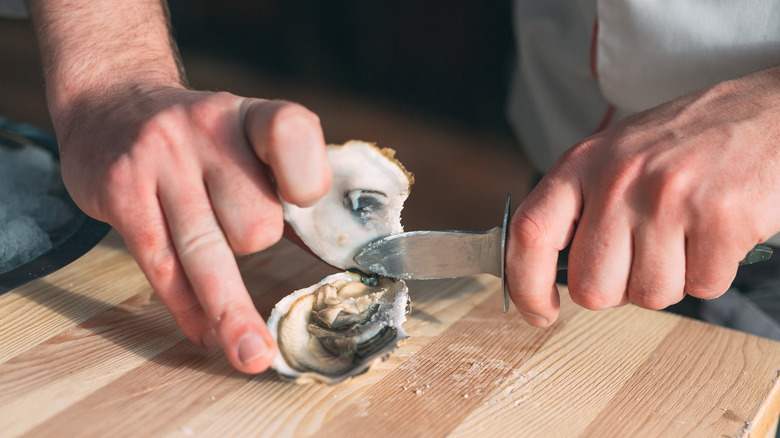Next Time You Eat Raw Oysters, Just Know That They Might Be Alive
Seafood enthusiasts love to tout the tantalizing flavor profile of raw oysters. From the briny essence to the subtle sweetness of the meat to the umami finish, these bivalve mollusks pair beautifully with their signature accouterments. We're talking zesty mignonette, tangy cocktail sauce, fresh lemon wedges, and horseradish.
Oysters can be enjoyed in various ways, from eating them raw on the half shell with the aforementioned toppings and condiments to incorporating them into cooked dishes like chowders, Rockefeller-style preparations, or grilled oysters with flavorful accompaniments. Consider, too, that oysters are high in protein, iron, and omega-3 fatty acids. They're also rich in antioxidants and have reported benefits in the bedroom. What's not to love?
However, oysters have developed a bit of a reputation for dividing diners who may be squeamish about the texture. These contrarians may now have a new reason to question the oyster: they may still be alive when consumed, according to Business Insider.
Dealbreaker? It doesn't have to be. In fact, sucking down oysters that are alive (or close to it) could be the best and safest way to enjoy these fan favorites.
Can you tell if an oyster is alive before eating it?
There are not necessarily any hallmarks of life to look for when presented with a plate of raw oysters. When dining in most restaurants, it's safe to assume that they are either alive or were recently killed. (Yes, you may be consuming a dying oyster.) "When you slurp back oysters raw, they are still alive or just freshly killed or shucked prior to serving, which is why you oftentimes see them on ice," Alex Lewis, a dietitian for Baze, told Eating Well.
The shucking process, which involves opening the shell to access the live oyster inside, severs the adductor muscle of the oyster, often killing it. When you consume a freshly shucked oyster, it is indeed alive or at least very recently deceased. But don't worry, they can't feel pain — at least we don't think so. "They don't have a brain; they're not really processing pain the same way we are," Julie Qiu, founder of In A Half Shell and an oyster expert, told Business Insider.
Keeping oysters alive prevents bacterial contamination
Experts and foodies say serving oysters raw, as fresh as possible, not only preserves the flavor, it also helps maintain nutrients, which can be degraded by the cooking process. But another key reason raw oysters are best consumed alive or freshly killed is the risk for bacterial contamination is lower. Lewis, the dietician, told Eating Well, "Dead raw oysters run a greater risk of being infected with viruses and bacteria that can have a negative impact on your health — although the overall risk is relatively low."
The biggest threat when consuming raw oysters is contamination with a bacteria called vibrio which, according to the U.S. Centers for Disease Control and Prevention, can cause diarrhea, vomiting, or even more severe infections. Vibrio vulnificus, in particular, can lead to bloodstream infections and skin lesions that may require limb amputation.
Scary stuff, but not as common as one might think. The CDC notes that about 100 people in the United States will die from a vibrio infection in a given year, compared with an estimated 420 deaths from salmonella according to the FDA.
To ensure your oysters are fresh and you don't get sick, diners can request to see a restaurant's shellfish tag. The U.S. Food and Drug Administration requires the label to be available for 90 days after purchase in the event the oysters need to be tracked back to their supplier or original water source.


